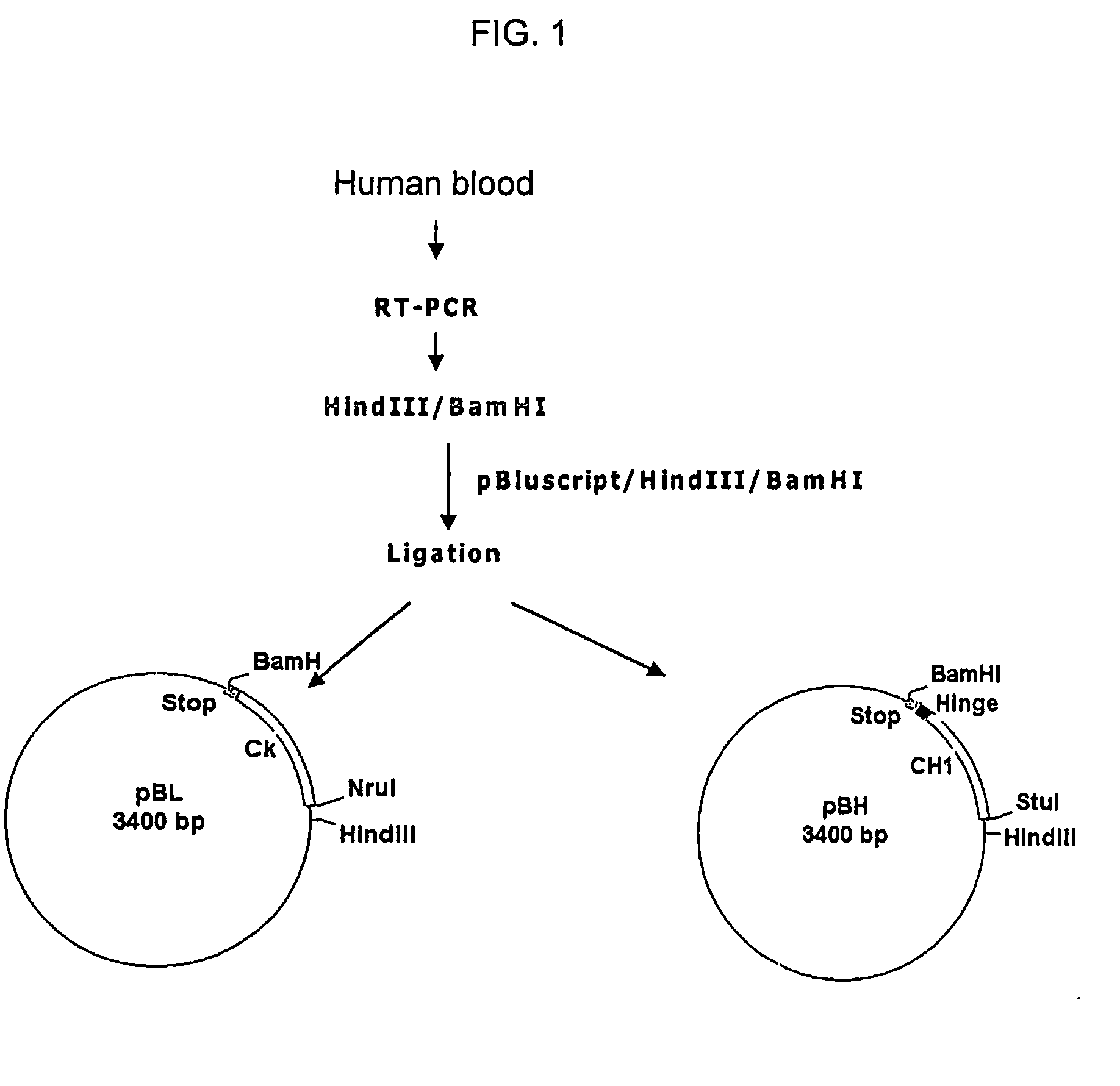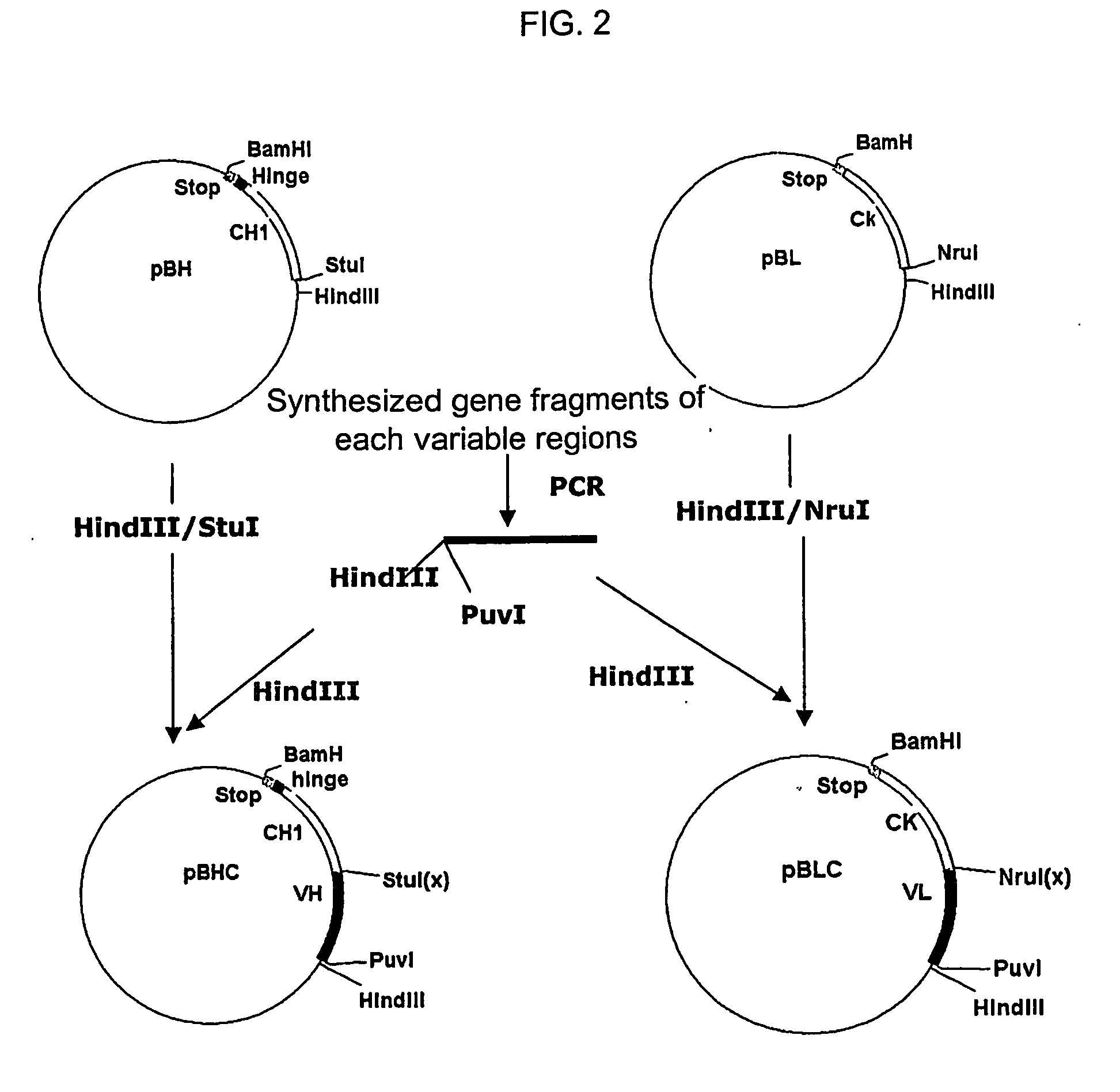Expression vector for secreting antibody fragment using e. coli signal sequence and method for mass-producing antibody fragment
a technology of e. coli signal sequence and expression vector, which is applied in the field of recombinant expression vector, can solve the problems of cumbersomeness and economic unfavorability
- Summary
- Abstract
- Description
- Claims
- Application Information
AI Technical Summary
Benefits of technology
Problems solved by technology
Method used
Image
Examples
examples 1
Cloning of the Gene Encoding Anti-Tumor Necrosis Factor-α Fab′
[0049]Variable regions of a heavy chain and a light chain of human anti-tumor necrosis factor-α Fab′ were synthesized using a nucleotide synthesizer, referring to the nucleotide sequences disclosed in International Patent No: WO97 / 29131. Gene fragments for cloning the light chain variable region had the nucleotide sequences of SEQ ID NOs: 1 to 6, and gene fragments for cloning the heavy chain variable region had the nucleotide sequences of SEQ ID NOs: 7 to 12. To facilitate the subsequent cloning procedure, recognition sites of HindIII and PvuI restriction enzymes were inserted into the first gene fragment of each of the genes encoding the light chain and the heavy chain (i.e., SEQ ID NOs: 1 and 7), respectively. Each of the synthesized gene fragments of the light chain and the heavy chain was mixed in one tube and subjected to a conventional PCR to link them in one gene sequence, respectively, to obtain the genes encodin...
example 2
Construction of Anti-Tumor Necrosis Factor-α Fab′ Gene Expression Vector
[0052] Construction of an Expression Vector Comprising E. coli Thermostable Enterotoxin Signal Sequence Derivative and Anti-Tumor Necrosis Factor-α Fab′
[0053]To construct an expression vector using E. coli thermostable enterotoxin signal sequence derivative, expression vector pT14S1SH-4T20V22Q (Korean Patent No: 316347) expressing human growth hormone (hGH) was employed. The expression vector contained a thermostable enterotoxin signal sequence derivative having the nucleotide sequence of SEQ ID NO: 17. In order to remove the hGH gene from the expression vector and insert the gene fragment encoding the heavy chain and the light chain prepared in Example 1 into the same site, a recognition site of StuI restriction enzyme was inserted into the fusion site between the thermostable enterotoxin signal sequence derivative and the hGH gene of plasmid pT14S1SH-4T20V22Q by site-directed mutagenesis using a primer pair of...
example 3
Expression of Anti-Tumor Necrosis Factor-α Fab′ Gene
[0066]E. coli transformants HM10920 to HM10925 prepared in Example 2 were inoculated into a fermentor (Marubishi) in volume of 5 l, subjected to fermentation, and then, the expression of the anti-tumor necrosis factor-α Fab′ by each of the E. coli transformants was examined as follows.
[0067]Each of the E. coli transformants was cultured in 100 Ml of LB medium with shaking overnight, inoculated into the fermentor and subjected to main-culture. The fermentor's temperature was maintained at 35° C. or 30° C., air was injected into the fermentor at a rate of 20 vvm to prevent the development of an anaerobic condition, and the culture medium was stirred at 500 rpm. A supplementary energy source of glucose and a yeast extract with the growth of microorganism was supplied considering the fermentation state of microorganism. When the OD value at 600 nm reached 80, IPTG, an inducer, was added to the fermentor. The fermentation was further ca...
PUM
| Property | Measurement | Unit |
|---|---|---|
| temperature | aaaaa | aaaaa |
| volume | aaaaa | aaaaa |
| volume | aaaaa | aaaaa |
Abstract
Description
Claims
Application Information
 Login to View More
Login to View More - R&D
- Intellectual Property
- Life Sciences
- Materials
- Tech Scout
- Unparalleled Data Quality
- Higher Quality Content
- 60% Fewer Hallucinations
Browse by: Latest US Patents, China's latest patents, Technical Efficacy Thesaurus, Application Domain, Technology Topic, Popular Technical Reports.
© 2025 PatSnap. All rights reserved.Legal|Privacy policy|Modern Slavery Act Transparency Statement|Sitemap|About US| Contact US: help@patsnap.com



